By Ken Lain, the mountain gardener
This is the season when decorated evergreens dominate living rooms and sparkle in the winter landscape. The list provided not only grows best outdoors but often is used as a living tree through the holiday celebrations then planted outdoors when the festivities are over.
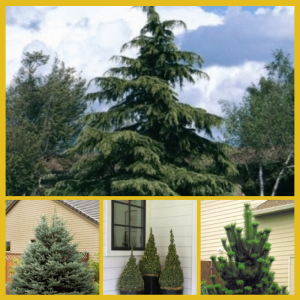
(There are links at the end of this article for proper mountain planting and proper irrigation.)
Here is a list of the top 10 evergreen trees that stand up to mountain wind, winter cold, and resist the naturally occurring insects and diseases found at higher elevations. You will find each at the garden center, and links are provided for further research and to buy directly from the farm.
Colorado Spruce – When customers don’t know the name of this tree they just refer to it as “The one that looks like a Christmas tree.” The very thick branches swoop horizontally forming a 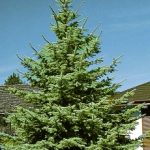 perfect broad pyramid. Drought hardy, this tree prefers dry, windy conditions.
perfect broad pyramid. Drought hardy, this tree prefers dry, windy conditions.
- Con– Tree aphids like the taste of native ponderosas and of Colorado Spruces. They rarely do serious damage and are easily spotted in mid-spring as new growth elongates.
- Pro – Ancient specimens are living proof that this tree does well. Feed with aluminum sulfate to bring out the silver blue of this perfectly formed tree. Size: 60’H x 20’W
Austrian Pine – This long-needled evergreen often is mistaken for a young ponderosa pine although it is far more graceful. Whereas the ponderosa loses all its lower branches as it matures, the Austrian’s rich green needles seem to flow right to the ground for a balanced appearance. The dense, stout, pyramidal growth is uniform right to the crown. It is the hardiest of the ornamental pines without the bug issues that plague many native pines. It makes a most effective windbreak or privacy screen.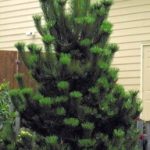
- Con – There aren’t many negatives other than that this is a fast-growing, big tree. It has been known to overpower walkways and eaves of a house when placed incorrectly in the yard.
- Pro – The fastest growing of all mountain pines. Can quickly grow 18 inches a year, and even more when under the care of an attentive gardener. Size: 35’H x 18’W
Juniper – The mountains of Arizona are famous for their juniper forests. A large assortment of junipers is found here at Watters in colors ranging from bright greens, blues, and silver. Excellent when planted as windbreaks or to provide thick privacy, and hardy enough for harsh commercial 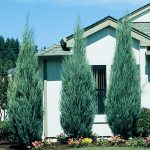 settings and investment properties.
settings and investment properties.
- Con – Spider mites sometimes transfer from native junipers into the landscape. Watch for spider webbing in mid-summer and treat with Watters ‘Multi Purpose Insect Spray‘ for instant protection. Many folks suffer from juniper allergies. However, if you are irritated by junipers keep in mind you are surrounded by thousands of acres of native junipers so one line of ornamental junipers cannot bear the full blame for your ailments!
- Pro – The toughest of all the evergreens with consistent growth over the season. So hardy they are the trees of choice for property investors and commercial property owners. Many can be hedged and sheared to perfection. Size: varies
Piñon Pine – A local native that is exceptionally hardy and drought tolerant, it is slow growing with a broad, rounded crown. Perfect for all natural landscapes it makes an attractive grouping on hillsides or berms with low-growing perennials. It can take a starring role as a striking specimen in a rock garden. New growth is blue to green with clusters of pinecones as the tree matures. Edible seeds from the cones are considered a delicacy, commonly known as pine nuts.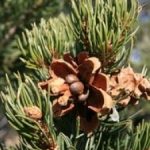
- Con – In early spring our native piñon is prone to scale that is easily treated. (The non-native Two Leaf Piñon Pine sold here at Watters is preferred for it’s larger pine nuts and its natural ability at fighting off scale.)
- Pro – Once established can grow completely on its own. A true native evergreen in the mountains, it is perfect for naturalizing the scars of construction. Size: 15’H x 10’W
Vanderwolf Pine – Take a close look and you will see that the top of each needle is blue with a green underside. This very stately pine is so soft that most homeowners literally hug these trees! 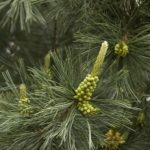 Its very unusual and distinctive shape is unique to mountain landscapes.
Its very unusual and distinctive shape is unique to mountain landscapes.
- Con – Unreceptive to thick heavy clay soil and/or a gardener with a heavy hand on the hose. Don’t overwater this evergreen or you could lose it within the first year of planting.
- Pro – The color is stunning. Requires little to no pruning. Very low water user. Size: 25’H x 12’W
Fat Albert Blue Spruce – Sporting a shape similar to that of the Colorado Spruce, Fat Albert doesn’t grow as tall, so it won’t overtake more than its allotted space. A broad pyramidal shape with exceptional blue needles that present a consistent blue color.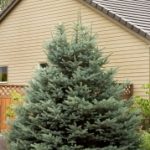
- Con – I really can’t think of any cons for this tree! I did see grubs eat some roots of a Fat Albert this spring, but that is a very rare sight.
- Pro – Intense silver-blue needles adorn this tree. The choice for those that love a Christmas tree shape but need a tree with a small footprint. Size: 25’H x 12’W
Dwarf Alberta Spruce – This slowest growing of the evergreens is the easiest to maintain. Its perfect cone shape displays dense green soft-to-the-touch needles. Although it often is used to make a formal statement in a garden, it is excellent as a container plant or miniature Christmas 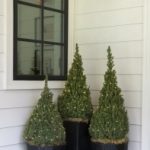 tree.
tree.
- Con – Watch for spider mite webs that can form in June. Spider mites like the taste of an Alberta Spruce but are easily thwarted by using Watters ‘Multi Purpose Insect Spray‘ for instant protection.
- Pro – A small format evergreen that needs little to no maintenance, but has that classic evergreen look and feel. Perfect for large containers framing the garage, accenting decks, and highlighting pots at the front door. Size: 8’H x 3’W
Arizona Cypress – This tree is a real celebrity in the local garden world. Often mistaken for a juniper, but this blue evergreen forms a golfball-sized cone instead of juniper berries, making it less allergy- inducing than a native juniper. Very fast growing and readily tolerates mountain soil, valley winds, and bitter winter cold.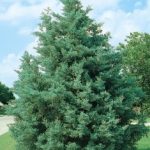
- Con – Carefully watch the frequency of irrigation the first couple of years after planting. If you are going to kill this evergreen it will be from over-watering, not from under-watering.
- Pro – This fast grower should be a serious consideration for dry, dusty properties exposed to the elements of mountain living. Deer- and javelina-resistant. Size: 20’H x 10′
Deodar Cedar – This fast grower has a central leader with soft branches that sway gracefully in 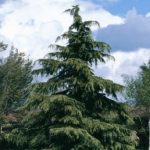 the wind. So large a tree that it fits only in the largest properties.
the wind. So large a tree that it fits only in the largest properties.
- Con – Such a fast grower it often overpowers the landscape. Soft branches can break from heavy snowfalls. Needs more regular feeding than other evergreens or it will become yellow and off-color.
- Pro – Fast growing and drought hardy are this tree’s claims to fame. Size: 50’H x 25’W
Black Hills Spruce – With the deepest green of any evergreen and a density that light dares not shine through, this spruce’s perfect cone-shaped symmetry stands out in any landscape. It’s so cold-hardy that it actually prefers being planted in winter! Although the tree looks delicious, neither javelina nor deer like to nibble on it.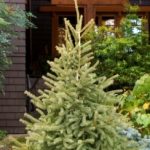
- Con: A painfully slow grower, but methodical in its development. Very sensitive to garden soils that do not drain properly.
- Pro: An easy to grow pine with beautifully blue-colored needles. Slow, methodical growth means little-to-no maintenance is needed throughout this tree’s long lifespan. Size: 35’H x 16’W
Norway Spruce – A dense tree that easily blocks out wind and neighbors, the Norway is ideal for use as a privacy barrier, windscreen, or even a traditional showpiece. Grows faster than other 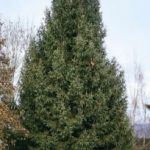 spruces, but with a bright Irish green needle
spruces, but with a bright Irish green needle
- Con – Such a fast grower it can quickly outgrow the average yard. Staking the young tree is necessary to keep soft, fast-growing leaders from bending in the wind.
- Pro – Takes the funneled wind, intense sun, and bad soil better than most other evergreens. Loves growing at mountain elevation. Size: 50’H x 25’W
Local Planting Guide & Proper Irrigation – These are the links on how to plant and appropriately irrigate winter evergreen trees.
Planting & Delivery Service – Evergreens are unusually bulky and heavy so while being installed in a landscape can inflict bodily damage to the installer. After planting a mature evergreen tree it’s possible to look like you’ve been in a cat fight, and the cat won! So consider having the garden center plant it for you; you will consider the cost as money well spent.
Of course, the larger the tree the more work it is to install so the more it costs to plant. The average size tree that stands head high costs about $100, and includes the warranty, labor, and all the materials to plant it right.
Until next week, I’ll be helping local gardeners with the best evergreen trees here at Watters Garden Center.
Ken Lain can be found throughout the week at Watters Garden Center, 1815 W. Iron Springs Rd in Prescott, or contacted through his website at WattersGardenCenter.com or FB.com/WattersGardenCenter .


My boss bought me a live blue spruce for the office this year. When is the best time to transplant it into the ground?
Depends on your location. In Northern AZ most anytime is a good time to transplant.